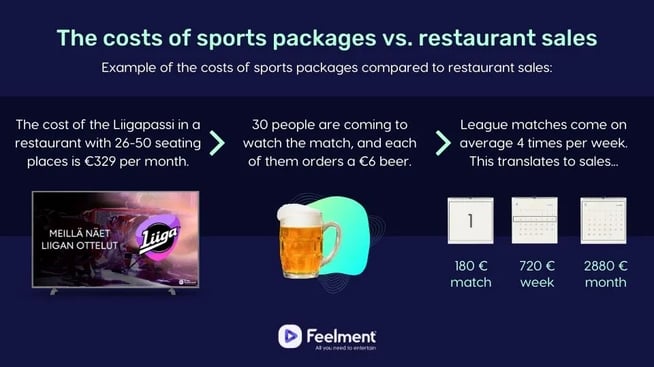A restaurant professional might rub their eyes in disbelief when comparing the price lists of sports channel packages. The service intended for consumers has a completely different price range compared to that for restaurants. Moreover, there is variation among service providers as well. The price differences raise questions about the profitability of showing sports and spark doubts about whether there's some padding in the price lists. Are these reflections accurate, or are they myths in the restaurant industry? We set out to investigate.
The audience matters
The prices of sports packages designed for restaurants are always based on the number of seating places. So, the more viewers, the higher the price. This is why the prices of sports packages for consumers and businesses cannot even be compared. Currently, only a handful of people may be watching a sports broadcast at home, while in a restaurant, there could be up to 200 pairs of eyes.
The pricing criteria for consumer-oriented channel packages are based on personal use and do not include licenses allowing commercial use. For example, C More's terms of use prohibit commercial use of the service, meaning that showing a sports package intended for home use in a restaurant is illegal.
Why are there differences in channel package prices?
So, the prices of channel packages are based on the size of the audience and the costs associated with commercial use. However, there are differences in the prices of various channel packages, even if the service is ordered for the same number of viewers. Do certain service providers inflate prices, or what is the reason for this? These prices are not pulled out of thin air but are always based on the content offered by the channel package. The rights to broadcast sports are divided among several different entities, leading to variations in price lists.
For example, comparing the pricing of C More and Ruutu reveals a significant difference. Although both channel packages offer comprehensive and interesting sports content, there are differences in their content. Ruutu includes a lot of domestic sports, while C More has made agreements with major international players. C More's pricing is also influenced by exclusive broadcasting rights for certain matches. This pattern is also evident in the pricing of V Sport, which is very close to C More's price range.
While the abundance of channel packages may sometimes cause frustration, it is ultimately a positive aspect in terms of price competition. If sports were only available through one channel, that provider could dictate the prices. Competition is, therefore, beneficial for prices. The diversification of sports content also doesn't necessarily mean dealing with multiple cables and set-top boxes. Restaurants, at their best, can display all sports content from a single device simultaneously. Do you know how? Check it out here.
The costs of sports packages vs. restaurant sales
So, there are clear reasons behind the pricing, but this still doesn't answer one of the restaurant industry's biggest questions: Is it profitable to pay for sports channel packages? This can be considered through an example. As seen in the image below, Telia's Liigapassi currently costs €329/month for a restaurant with 26–50 seating places. While watching sports, customers get thirsty and order drinks. If 30 people have come to watch a match, each ordering a €6 beer during the evening, the sales from just the beers amount to €180. Since there are, on average, 4 League matches per week, weekly sales accumulate to €720, and monthly sales reach €2880. Not a bad balance for the sale of just one beer. Additionally, it's worth noting that in reality, customers' purchases are often more than just one beer. Sales speak for themselves; sports matches attract customers to come in, stay a bit longer, and order more.

Those horrified by the costs should actually compare the price lists of sports packages to the benefits they bring. Although the prices may initially seem high, they are based on very rational grounds. And showcasing sports is not as expensive as one might think, as the matches displayed in the restaurant pay off through increased sales. Investing in sports is profitable in every way—so, we give the myths a red card.